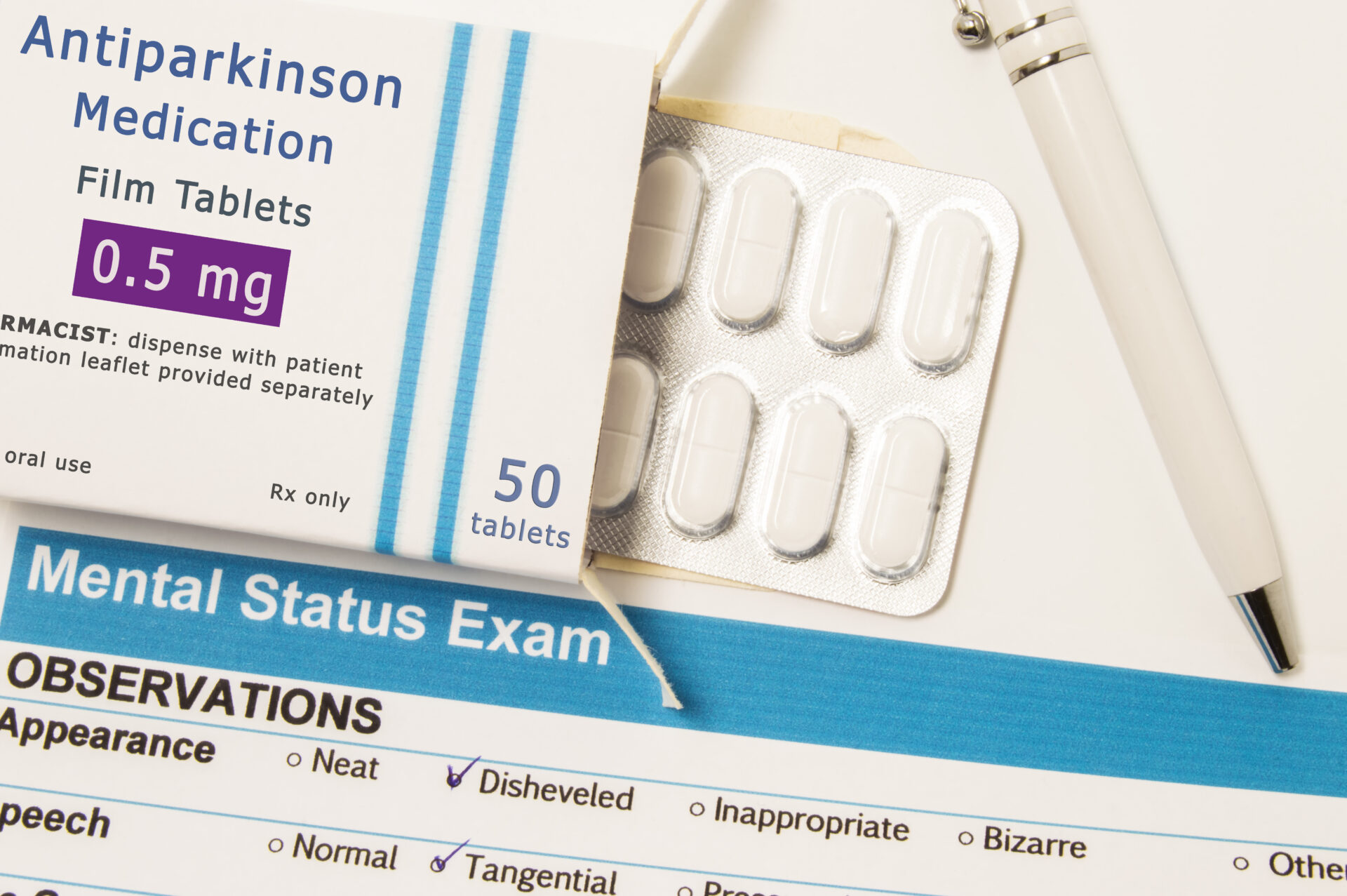Antiparkinson agents are specialized medications that address the chemical imbalances in the brain that occur with Parkinson’s disease. These substances work by either replacing dopamine, mimicking its effects, or preventing its breakdown in the brain.
In managing the condition, patients must carefully weigh the benefits and costs of Parkinson’s disease medications and their side to develop regimens that effectively address symptoms while maintaining quality of life.

Parkinson’s Disease Symptoms
Parkinson’s disease is a progressive neurodegenerative disorder that primarily affects movement. It develops when neurons in the brain that produce dopamine, a chemical messenger responsible for coordinated movement, gradually break down or die.
The disease typically begins around age 60, although early-onset forms can occur before age 50. According to insights from the National Institute of Neurological Disorders and Stroke, as many as one million Americans are living with Parkinson’s disease [1].
The main symptoms of Parkinson’s disease include [2]:
- Bradykinesia: This means that one has a decreased speed of movement.
- Postural Instability: This can include balance problems and stooped posture.
- Tremor: This symptom typically begins in one hand.
- Rigidity: This can include stiffness in the limbs and trunk.
- Speech and Writing Changes: Examples include slurred or hesitant speech or difficulty writing.
- Loss of Automatic Movements: These movements include blinking, swinging one’s arms while walking, or smiling.
- Nonmotor Symptoms: These symptoms can include anxiety, sleep problems, depression, constipation, olfactory issues, impaired memory, or lethargy.
Parkinson’s Disease Progression
Parkinson’s disease follows a progressive course that varies significantly from person to person, with symptoms typically developing gradually over years. However, understanding the typical progression patterns helps patients and caregivers anticipate changes and adapt management strategies as needed.
- Early-stage Disease: In early-stage Parkinson’s disease, symptoms are typically mild and often confined to one side of the body. Patients may notice a slight tremor in one hand, mild rigidity, or subtle changes in posture and facial expression. These initial symptoms rarely interfere significantly with daily activities and symptoms typically respond well to medication [1].
- Mid-stage Disease: As the disease progresses to mid-stage, symptoms typically affect both sides of the body and become more pronounced. Balance problems emerge, movements slow further, and falls become more common. Medication effects may begin to fluctuate, with some medications decreasing in effectiveness between doses [1].
- Advanced Disease: Advanced Parkinson’s disease brings more significant challenges, including the freezing of one’s gait, increased fall risk, and greater difficulty with activities of daily living. Non-motor symptoms often become more prominent, including cognitive changes, hallucinations, sleep disorders, and autonomic dysfunction (i.e. problems with the body’s autonomic nervous system functions, such as heart rate and blood pressure). Many patients develop fluctuating responses to medications, with unpredictable “on” and “off” periods [3].
Disease progression rates vary substantially, with some people experiencing slow progression over decades, while others advance more rapidly. While Parkinson’s disease isn’t considered fatal, advanced disease can cause complications such as swallowing difficulties, which can in turn lead to aspiration pneumonia (an infection caused by breathing something other than air into the lungs). As a result, these complications can lead to serious health issues.
Parkinson’s Diagnosis and Treatment Options
Since a specific test to identify Parkinson’s disease doesn’t exist, neurologists diagnose the condition based on a comprehensive medical history, a review of symptoms, and a neurological and physical examination. Tests and procedures used to diagnose the condition include: blood tests and lab tests to rule out other conditions, imaging tests such as MRIs or brain ultrasounds, and dopamine transporter (DAT) scans that can help support the suspicion of Parkinson’s disease [4].
Following a diagnosis, treatment usually comprises a multifaceted approach tailored to each person’s symptoms and disease stage. Often forming the cornerstone of management, antiparkinson medications are a diverse group of pharmaceutical drugs designed to address the dopamine deficiency that characterizes Parkinson’s disease.
Treatment typically begins when symptoms interfere with daily activities, and medication regimens are carefully tailored to each person’s specific symptoms, age, and disease progression. While these medications can significantly restore the balance of neurotransmitters, decrease motor symptoms, and improve quality of life, they primarily manage symptoms rather than altering the underlying disease process [5].
Additionally, comprehensive management for Parkinson’s disease also includes rehabilitation therapies that address specific functional limitations, regular exercise, and surgical options [3].
Treatment with Levodopa and Carbidopa
Among the arsenal of medications available for Parkinson’s disease symptom management, levodopa is one of the most effective [1]. It crosses the blood-brain barrier and converts to dopamine in the brain to replenish depleted levels. This helps treat Parkinson’s as the disease results in decreased dopamine levels.
However, when administered alone, only a small fraction of levodopa reaches the brain, as most is metabolized (i.e. converted) to dopamine beforehand in the bloodstream. This typically leads to significant side effects such as nausea, vomiting, and low blood pressure [6].
To minimize these side effects, levodopa is usually combined with an enzyme inhibitor drug called carbidopa. This combination allows more levodopa to reach the brain while significantly reducing side effects [6]. Available in several formulations, these medications provide flexibility in managing symptoms at different disease stages [4].
Levodopa/carbidopa therapy typically provides a dramatic improvement in motor symptoms, especially in those with early-stage Parkinson’s disease. However, as the disease progresses and more dopamine-producing neurons are lost, the effectiveness of levodopa/carbidopa may diminish, and patients often require higher or more frequent doses [5].
Treatment with Dopamine Agonists and Anticholinergics
Dopamine agonists are a critical class of antiparkinson medications that work by directly stimulating dopamine receptors in the brain, mimicking the action of natural dopamine. This function is important as Parkinson’s develops when neurons in the brain that produce dopamine break down or die. Unlike the drug levodopa, which requires conversion to dopamine, these medications bind directly to dopamine receptors, activating them even in the absence of dopamine-producing neurons [6].
Dopamine agonists are often used in the early stages of Parkinson’s. They can be prescribed alongside levodopa in order to lengthen its duration of effectiveness [6]. Some of the more commonly prescribed dopamine agonists include: pramipexole (Mirapex), apomorphine (Apokyn), and rotigotine (Neupro), the latter of which is offered as a transdermal patch that provides continuous drug delivery over 24 hours [4].
While rarely used today, anticholinergics offer another treatment option for Parkinson’s disease symptoms. These medications block the neurotransmitter acetylcholine, helping restore balance between acetylcholine and dopamine. This can lessen Parkinson’s symptoms.
Anticholinergics, including benztropine, orphenadrine, procyclidine, and trihexyphenidyl, are effective for managing tremor. However, they’re less helpful for other symptoms and often include significant side effects. For example, benztropine uses include reducing muscle rigidity and controlling tremor, though side effects such as dry mouth, blurred vision, urinary retention, and confusion limit its use [7].
Treatment with MAO-Bs and Amantadine
Monoamine oxidase B (MAO-B) inhibitors block an enzyme that normally breaks down dopamine in the brain. Thus, MAO-B inhibitors allow naturally produced dopamine and dopamine formed from levodopa to remain active in the brain for longer periods [6]. This further limits symptoms of Parkinson’s, which is characterized by the loss or breakdown of dopamine-producing neurons.
Commonly used MAO-B inhibitors include selegiline (Zelapar, Eldepryl, Emsam), safinamide (Xadago), and rasagiline (Azilect) [5]. Often used as an initial form of treatment, MAO-Bs can relieve motor symptoms, delay the need for therapy with the drug levodopa, and reduce the risk of levodopa-induced motor complications [5].
However, along with side effects such as confusion, nausea, insomnia, and headaches, MAO-Bs can also cause hallucinations, particularly when they’re used alongside the combination of levodopa/carbidopa [4].
In contrast to MAO-Bs, amantadine was originally developed as an antiviral medication for influenza. While researchers don’t fully understand its anti-Parkinson’s effects, amantadine for Parkinson’s disease helps reduce twitching, resting tremors, rigidity, and fatigue. Plus, it can be used to lower the required dosage of levodopa [5].
Supportive Therapies for Parkinson’s
Beyond pharmaceutical treatment, comprehensive Parkinson’s disease management includes the following range of supportive therapies [8]:
- Physical Therapy: PT plays a key role in maintaining mobility and flexibility, with therapists designing specialized exercise programs that focus on improving gait, balance, and posture.
- Occupational Therapy: OT provides strategies and tools to maintain independence in daily activities.
- Speech Therapy: Speech therapy is a form of treatment for communication disorders that also addresses the swallowing difficulties that often develop with Parkinson’s.
- Nutritional Counseling: Dietary changes may improve some symptoms or pharmaceutical side effects. For example, added fiber and water consumption can minimize constipation, increased salt and smaller and more frequent meals can aid issues with dizziness and low blood pressure, and elevated caloric consumption can prevent unintentional weight loss.
For those who don’t respond to medication, advanced Parkinson’s disease treatment options offer more invasive steps that may improve motor symptoms. These include deep brain stimulation (DBS) and continuous apomorphine infusions [3].
Additionally, treatment options continue to evolve, with several new treatments for Parkinson’s disease showing promise. For example, researchers are working to deliver genes that can increase dopamine production or provide neuroprotection directly to affected brain regions. Cell-based therapies, including the transplantation of stem cells or dopamine-producing cells, aim to replace lost neurons and restore normal function [5].
Living with Parkinson’s Disease
Navigating life with Parkinson’s disease requires adaptability, resilience, and a proactive approach to health management. While living with Parkinson’s presents unique challenges, comprehensive care and supportive strategies enable many people to maintain fulfilling, active lives for many years after diagnosis. A multidisciplinary approach that combines medication management, rehabilitation therapies, and lifestyle modifications offers the best foundation for maintaining quality of life and independence.
It’s also important to note that creating a strong support network is invaluable for those living with Parkinson’s disease. Family members, friends, healthcare providers, and support groups all play essential roles in providing practical assistance, emotional support, and valuable information. Ongoing advances in treatment options and management strategies provide genuine reasons for optimism in the face of this challenging condition.
- National Institute of Neurological disorders and Stroke. (2025, February 25). Parkinson’s disease: Challenges, progress, and promise. National Institute of Neurological disorders and Stroke. https://www.ninds.nih.gov/current-research/focus-disorders/parkinsons-disease-research/parkinsons-disease-challenges-progress-and-promise. Accessed 29 April 2025.
- Mayo Clinic. (2024, September 27). Parkinson’s disease: Symptoms and causes. Mayo Clinic. https://www.mayoclinic.org/diseases-conditions/parkinsons-disease/symptoms-causes/syc-20376055. Accessed 29 April 2025.
- Giugni, J. C., & Okun, M. S. (2014). Treatment of advanced Parkinson’s disease. Current opinion in neurology, 27(4), 450–460. https://pmc.ncbi.nlm.nih.gov/articles/PMC4140171. Accessed 29 April 2025.
- Mayo Clinic. (2024, September 27). Parkinson’s disease: Diagnosis and treatment. Mayo Clinic. https://www.mayoclinic.org/diseases-conditions/parkinsons-disease/diagnosis-treatment/drc-20376062. Accessed 29 April 2025.
- Stoker, T. B., & Greenland, J. C. (Eds.). (2018). Parkinson’s Disease: Pathogenesis and Clinical Aspects. Codon Publications. Chapter 7. https://www.ncbi.nlm.nih.gov/books/NBK536726.
- Cleveland Clinic. (2023, November 9). Parkinson’s disease medications. Cleveland Clinic. https://my.clevelandclinic.org/health/treatments/parkinsons-disease-medications. Accessed 29 April 2025.
- ParkinsonsDisease.net. (2025 April). What are anticholinergics? ParkinsonsDiesease.net. https://parkinsonsdisease.net/medications/anticholinergics. Accessed 29 April 2025.
- National Health Service. (2025, November 3). Treatment: Parkinson’s disease. National Health Service. https://www.nhs.uk/conditions/parkinsons-disease/treatment. Accessed 29 April 2025.
The Clinical Affairs Team at MentalHealth.com is a dedicated group of medical professionals with diverse and extensive clinical experience. They actively contribute to the development of content, products, and services, and meticulously review all medical material before publication to ensure accuracy and alignment with current research and conversations in mental health. For more information, please visit the Editorial Policy.
MentalHealth.com is a health technology company guiding people towards self-understanding and connection. The platform provides reliable resources, accessible services, and nurturing communities. Its purpose is to educate, support, and empower people in their pursuit of well-being.
Linda Armstrong is an award-winning writer and editor with over 20 years of experience across print and digital media.
Shivani Kharod, Ph.D. is a medical reviewer with over 10 years of experience in delivering scientifically accurate health content.
The Clinical Affairs Team at MentalHealth.com is a dedicated group of medical professionals with diverse and extensive clinical experience. They actively contribute to the development of content, products, and services, and meticulously review all medical material before publication to ensure accuracy and alignment with current research and conversations in mental health. For more information, please visit the Editorial Policy.
MentalHealth.com is a health technology company guiding people towards self-understanding and connection. The platform provides reliable resources, accessible services, and nurturing communities. Its purpose is to educate, support, and empower people in their pursuit of well-being.


